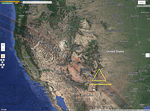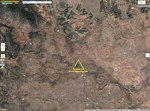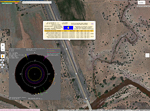
|

|
Annular Solar Eclipse |
Any seasoned eclipse chaser has the weather at the front of their mind as the eclipse time draws closer, and this one was no exception. Days ahead, the entire southwestern U.S. seemed to have a possibility of cloudy weather due to some high and low pressure regions, causing us to watch the weather prediction models closely. In the end, our first choice (near Santa Rosa, NM) seemed to be on the edge of an area of high clouds, so a day ahead we decided to head further northwest along U.S. 84 towards Las Vegas, NM. The move helped, but did not completely solve the cloud problem. Details of where we ended up are on the maps:
| Maps and Eclipse Circumstances |
|

High clouds, largely from aircraft contrails, allowed viewing the eclipse directly but degraded photography, especially in H-alpha.
The early morning air was brisk as the overnight low temperature was in the mid 30's (F) but as the sun rose, the temperature also rose. However, as the sun approached maximum annularity, the temperature actually dropped enough to be noticeable.

Greg and Vicki were traveling light as they were just at the beginning of a long road trip that would take them to Florida before heading home to Chicago! Greg's car in the background provided us the luxury of high-speed internet via a modified Starlink mobile connection (white antenna visible on his car). |

On the other hand, our photographic equipment included 3 setups -- a GM8 mount for a 4" white light Borg telescope and 2" H-alpha Borg scope, a Sky Watcher Star Adventurer GTi tracking mount for Jean's pinhole and binocular projection setup, and a Nikon D850 with 15mm fisheye lens for wide-field shots of the eclipse progression. |

|

|
Our final location was a bit deeper into the eclipse path than originally planned, but still allowed us an extended view of Baily's Beads on both 2nd and 3rd contact. Check out the C2 (2nd Contact) and C3 (3rd Contact) videos. The telescopic videos of the contact points are not great, having been a victim of "technical difficulties" right at second contact, but they give a sense of how long we had to enjoy the eclipse experience.
The beading is even evident in the binocular projection on Jean's real-time video at maximum annularity. Listen to the audio track on this video. We had our only two visitors drop by just after 3rd contact.




